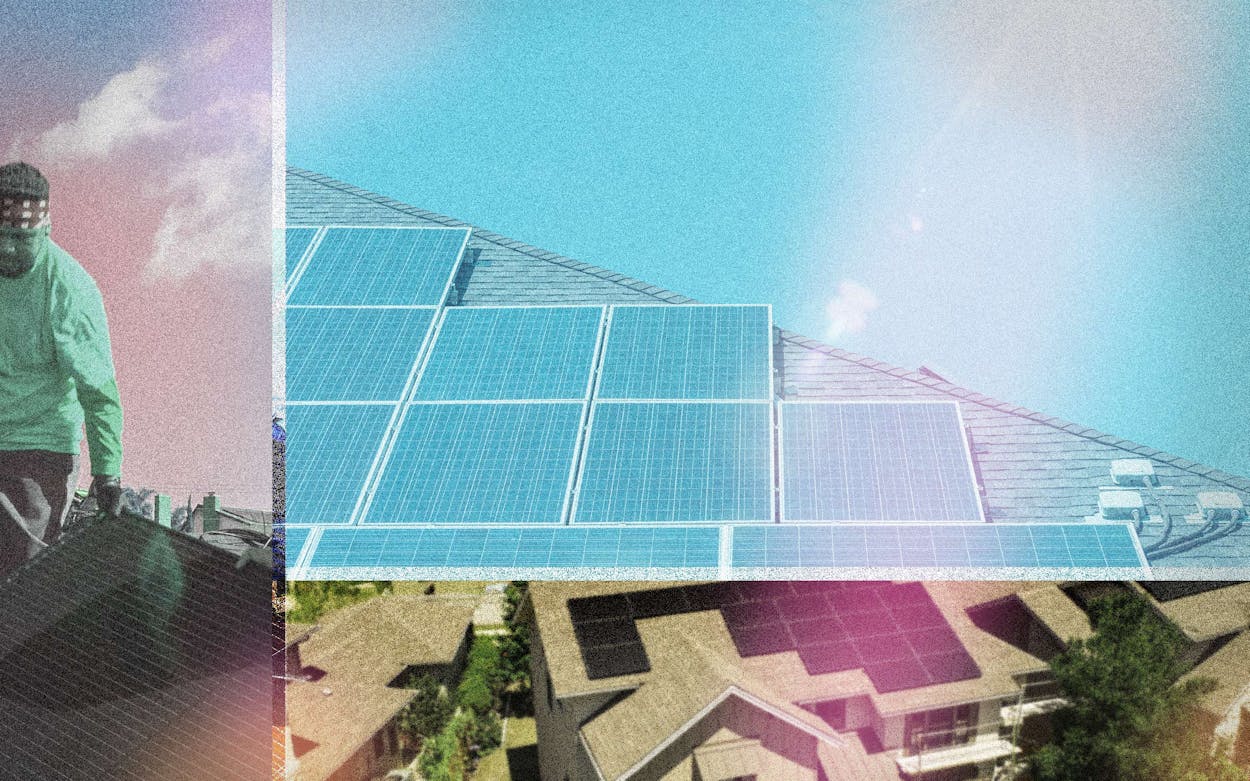Texas can barely keep up with growing demands for electricity driven by our state’s booming population and the extreme temperatures resulting from climate change. Yet we make it more difficult than it needs to be for homeowners to take stress off the grid by installing solar panels to power their own homes. Red tape and delays imposed by municipalities, utilities, and homeowners associations get in the way.
Our company, Freedom Solar, has thousands of customers with solar panels installed on rooftops waiting for interconnection across the state, with average delays ranging from five weeks in Austin and the Dallas–Fort Worth area to more than four months in Houston and San Antonio. Extrapolating from data gathered by the consultancy Wood Mackenzie, we estimate that Texas likely has more than one gigawatt of solar power awaiting approvals behind a pitiful web of unnecessary governmental and quasi-governmental paperwork. That’s enough electricity to power, on sunny days, all the households in Austin and Fort Worth.
All manner of home builders and contractors complain about the slow pace of bureaucratic permitting, but given that energy drawn from the sun has been preventing a calamity for the state’s grid this summer, special consideration should be given to streamlining regulations for solar projects. While, yes, we stand to benefit financially if such reforms are made, this is about much more than generating business for Freedom Solar. It’s about doing everything possible to stabilize our grid. And it’s about instituting plain old common sense.
Consider, for example, the plight of one of our customers, a couple in West University Place, a municipality carved out of southwest Houston, who recently commissioned rooftop solar panels for their house. They prefer that their names not be used, so let’s call them Mr. and Mrs. Green. Before the city government would approve the installation of their panels, the Greens were told, they needed to write letters to their neighbors informing them about their plans. They had to look up the names and addresses for two neighbors behind, two in front, and one on each side of their home. Then they were to deliver the required letters to the city, which would mail them to the neighbors. But their missives were rejected by the city because they had sealed the envelopes. The city had not previously told the Greens that the letters must be unsealed.
After the Greens returned with unsealed letters, the city informed them they needed to provide stamps for the letters. When Mrs. Green brought six stamps to the appropriate city office, she was told, “you need seven stamps because the city needs one to send a letter to the utility company.” She had to leave and return yet again, with a seventh stamp.
Weeks later, the Greens were still waiting for the city inspection of the installation (which was performed by a licensed electrician). They will also have to wait for their electric utility, CenterPoint, to certify the connection between the solar panels and the utility electricity. That certification is required even though the solar power is provided behind the home’s electricity meter and will not feed electrons back onto the grid. Mr. and Mrs. Green had their solar system designed in February 2022, yet here we sit in August with it still not in operation. (And the Greens are fortunate to live in a neighborhood without a homeowners association imposing its own hoops to jump through, as can often happen.) Peak-demand season may well be over before the couple’s panels can be helpful to the grid.
The next time you’re asked to turn up your thermostat on a hot day, remember all of the support the grid could be getting from solar panels that sit unapproved thanks to municipal red tape. Many Texans are trying to be a responsible part of the peak power-supply solution that solar offers (and without any state or local subsidies, though federal tax credits are available). They are demonstrating the appeal of solar adoption, for the good of their households and of the grid.
The Texas Tribune recently reported that the Public Utility Commission of Texas plans to develop a pilot program next year that would make it easier for homes and businesses with solar panels to contribute excess power to the grid and would pay them to do so. That’s encouraging, but we shouldn’t wait until next year to speed the installation of more solar systems. If utilities, local jurisdictions, and HOAs embraced distributed solar by removing unnecessary paperwork and fees, streamlining inspections, and adopting statewide codes, we could have a stronger, more resilient grid right now.
Bret Biggart is CEO of Freedom Solar, a solar-system installer based in Austin. Paul Hobby is managing partner of Genesis Park, a Houston-based private equity firm that has invested in Freedom Solar. Hobby is a former CEO and chairman of Texas Monthly.
- More About:
- Energy






